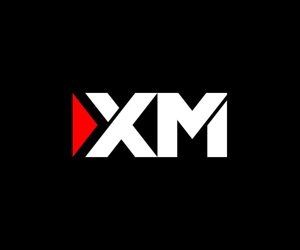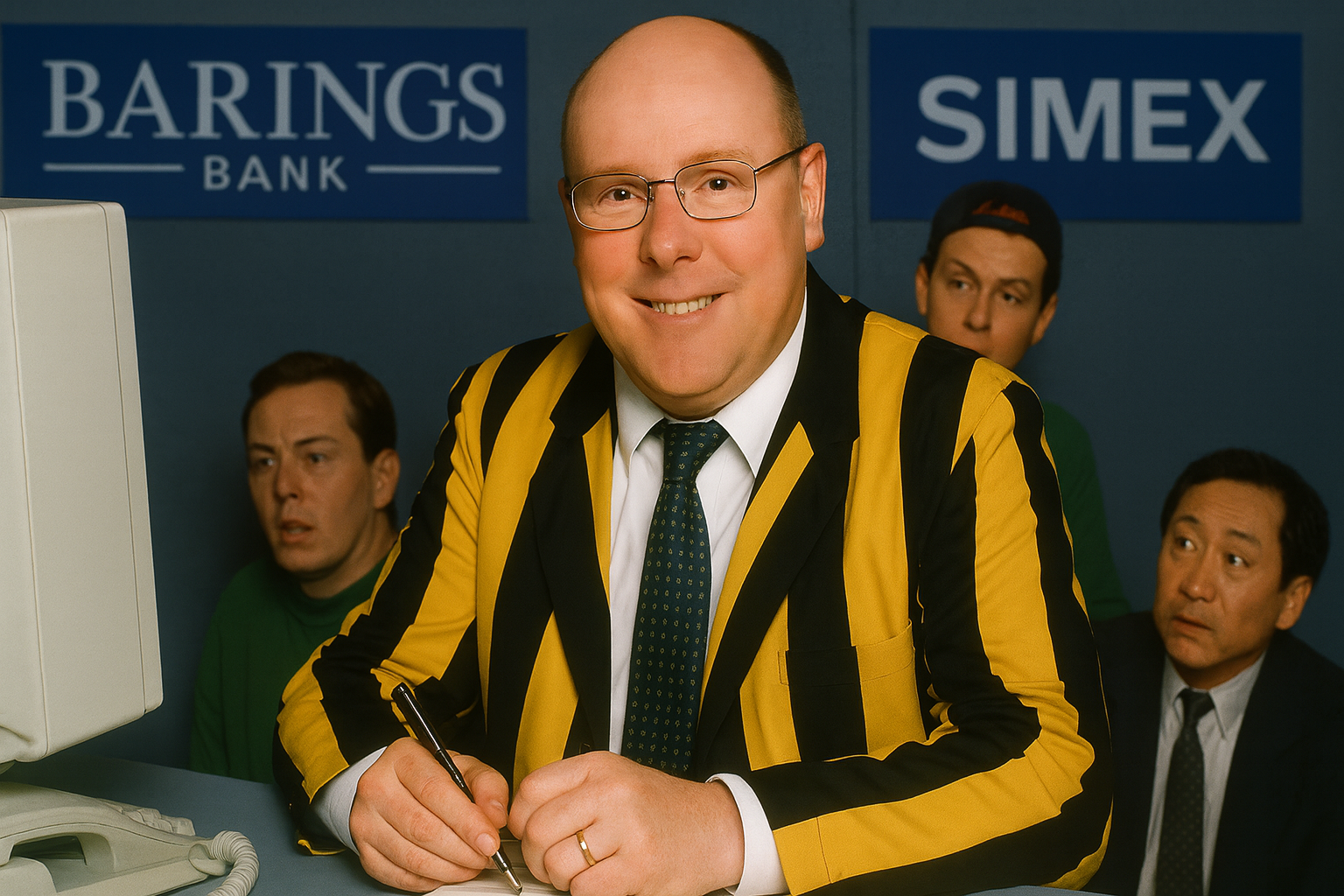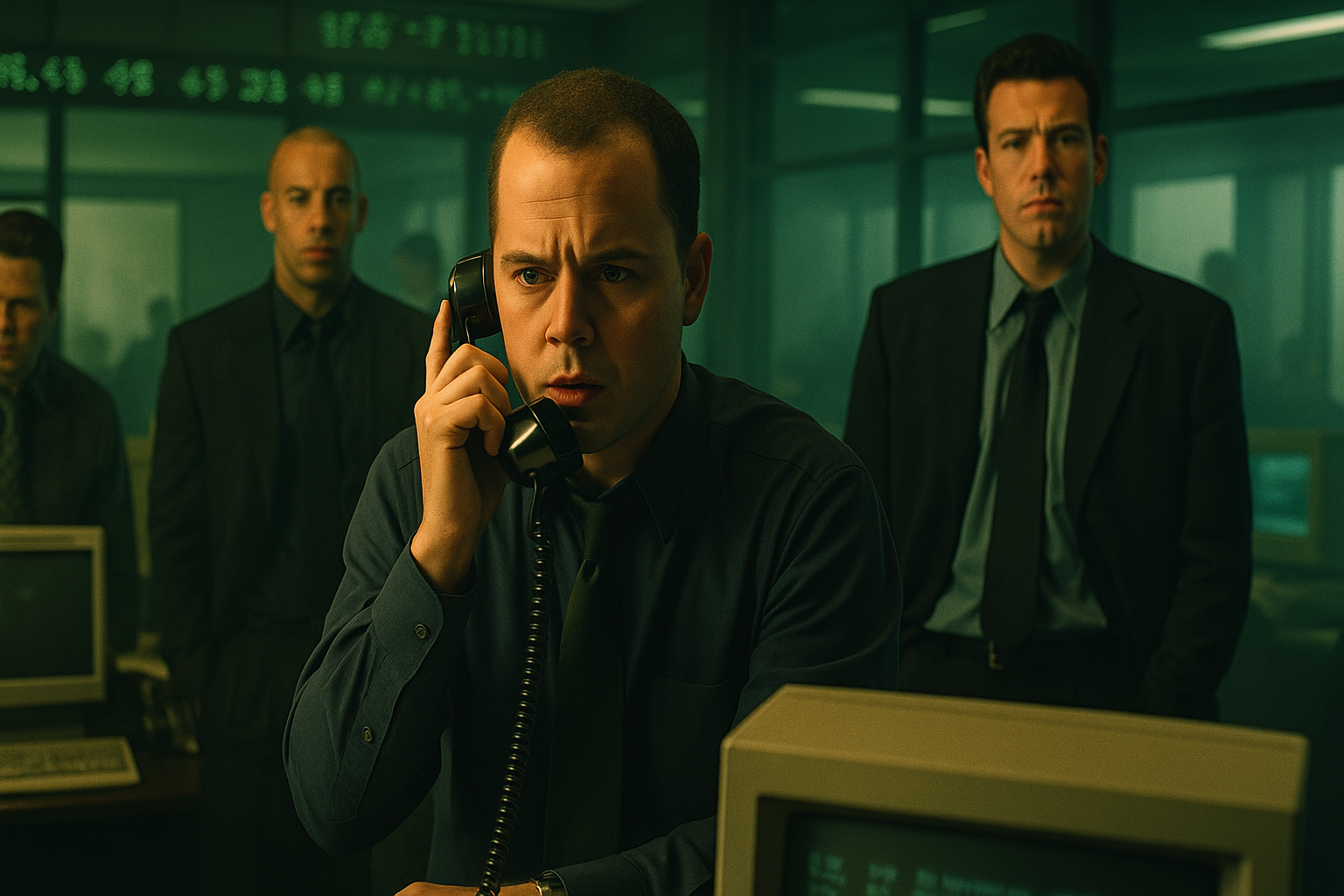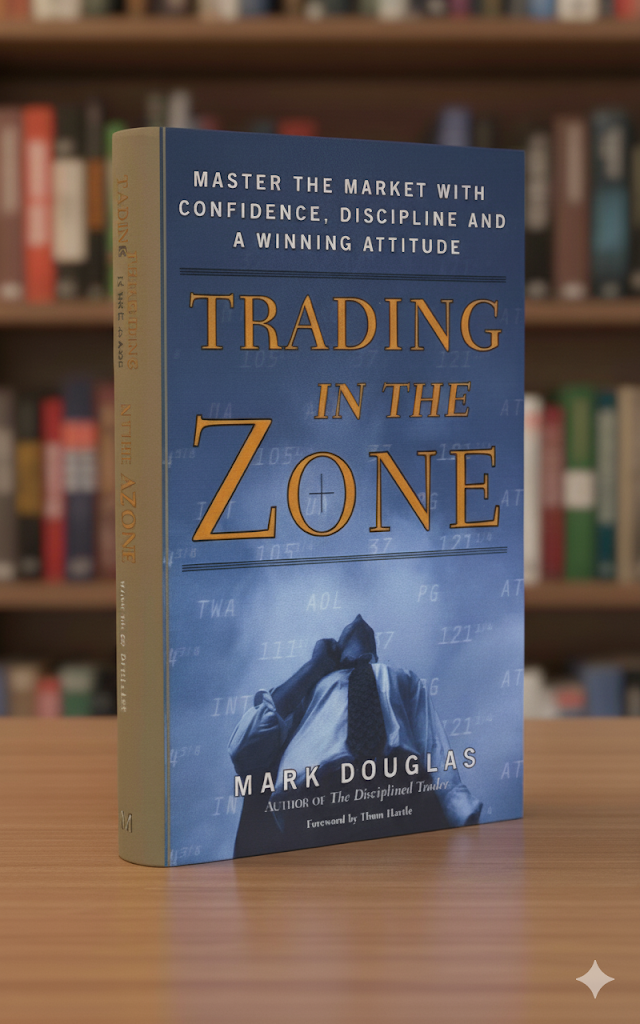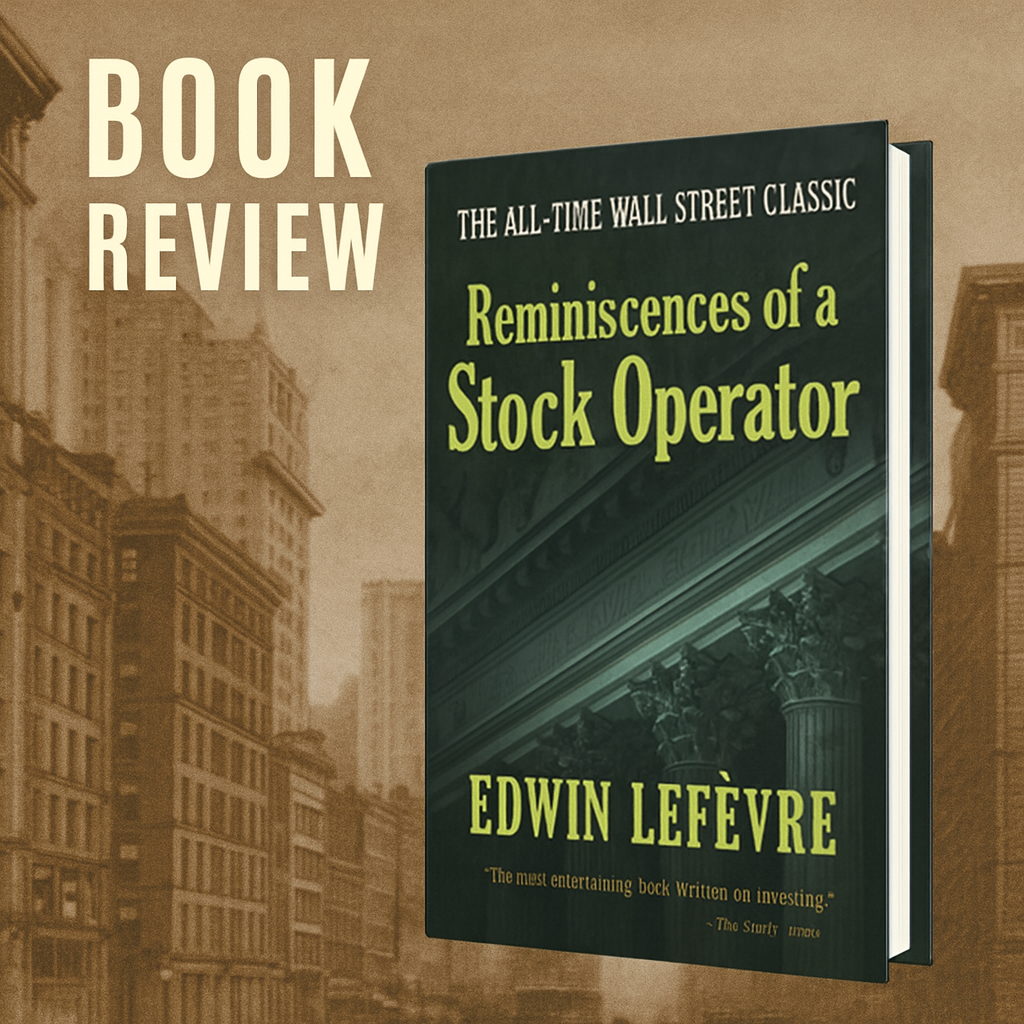Before the meme-stock frenzy of Dumb Money or the systemic collapse portrayed in The Big Short, there was Rogue Trader — the cautionary tale of one man whose hidden trades brought down Britain’s oldest merchant bank.
Synopsis
“Rogue Trader” (1999) dramatizes the rise and implosion of Nick Leeson, the 28-year-old derivatives trader whose hidden losses toppled Barings, Britain’s oldest merchant bank, in 1995. Played with nervy confidence by Ewan McGregor, Leeson is dispatched from London to Singapore to clean up back-office problems at the bank’s SIMEX operation. Instead, he installs himself as both front office and back office—head of trading and head of settlements—a structural sin the film rightly spotlights.
The plot traces a familiar arc: early wins, growing hubris, a clandestine “error account” (the now-infamous 88888), and a doubling strategy that metastasizes as losses mount. When positions go against him, Leeson conceals the damage, rolls losses forward, and sells more options—effectively shorting volatility to “earn back” what he’s lost. The Kobe earthquake in early 1995 spikes volatility and crushes his book. Margin calls swell. London management, flattered by apparent profits, asks too few questions. By the time Barings wakes up, the hole is terminal. The film ends with the collapse, Leeson’s arrest, and a postscript on a 233-year-old bank undone by one trader and a hollow control environment.
The screenplay compresses timelines and personalizes the consequences through Leeson’s marriage to Lisa (Anna Friel), but the core mechanics—concealed losses, leverage via futures and options, and a failed separation of duties—remain intact. Spoilers are unavoidable because the teachable moments are inseparable from the outcome: the bank fails because process failed long before prices did.
Cinematic Qualities
As cinema, “Rogue Trader” is brisk, competent, and workmanlike. McGregor’s performance is the engine—part swagger, part panic, capturing the adrenaline of a trader who confuses luck with edge. Friel brings texture to the domestic costs of deception, though the script gives her little beyond worry and disillusion. The direction favors pace over nuance, moving cleanly from trade floor to bar to boardroom, with enough jargon to feel credible without alienating a lay audience.
Production values are sturdy: late-stage Thatcher/early-Major Britain and mid-1990s Singapore feel lived-in; the SIMEX pit scenes have the right claustrophobic, analog energy—shouts, hand signals, and paper chits instead of blinking GUIs. The score is unobtrusive; the editing keeps momentum even as spreadsheets and margin calls threaten visual monotony. It’s not stylish like “The Big Short” nor operatic like “Wall Street,” but it does its job: it shows how ordinary decisions, repeated and rationalized, become extraordinary risk.
Trader’s Lens
At its core, the film is about leverage, liquidity, and control failures:
- Leverage via derivatives. Leeson’s book is built on index futures and options; small percentage moves translate into large P&L swings. The movie rightly underscores how mark-to-market and daily margin turn drift into drama.
- Short volatility and doubling down. He repeatedly sells options and adds to losing positions, effectively shorting tail risk. The premium collected is thin cover against convex losses—catastrophic when volatility gaps higher.
- Liquidity stress. When the market moves, the need for cash becomes immediate. The film shows the tyranny of margin: losses don’t wait for the next quarter.
- Control environment failure. The gravest lesson is not about a “bad apple” but a broken barrel. Combining trading and settlements annihilates independence. Management’s hunger for profit blinds oversight. Reports roll up to people who want to believe.
- Model risk and measurement error. The picture hints—if not explicitly—at VaR-style complacency: stable daily P&L and low measured volatility lull superiors, masking a crowded, ill-hedged book.
Lessons for Traders
- Segregation of duties is non-negotiable. Front office must never control back office. Independent confirmation, reconciliations, and exception reporting are the immune system; suppress them and a minor infection becomes sepsis.
- Process over outcome. Early wins that bypass controls are not validation; they are warning flares. If an edge depends on opacity, it is not an edge—it’s a liability.
- Respect convexity. Selling optionality feels like steady income until it doesn’t. Premiums are pennies; gamma is a freight train. If you sell tails, you must monitor exposure intraday, size ruthlessly, and pre-fund stress scenarios.
- Kill switches and hard limits. The film shows the absence of credible stop-losses, independent risk sign-off, and escalation protocols. Real shops enforce daily loss limits, position caps, and auto-de-risking when thresholds trip.
- Liquidity is your first risk. In futures, the calendar is not your friend; cash calls arrive before the narrative changes. Stress your funding, not just your P&L paths.
- Narrative discipline. Leeson tells himself he’s “buying time.” Traders do this. When your thesis mutates from price discovery to reputation defense, you’ve crossed into gambling.
- Culture eats controls. A boardroom that celebrates profits it doesn’t understand won’t ask the second question. If leadership fetishizes revenue without curiosity, risk will migrate to the shadows.
Accuracy vs. Dramatization
The film, adapted from Leeson’s memoir, is broadly faithful to the mechanics: the error account, the SIMEX structure, the use of futures and options, the corrosive effect of combined roles, and the crescendo around the Kobe earthquake. Timelines are compressed, relationships simplified, and some trades are streamlined for clarity. A few shortcuts underplay the role of London’s risk management—less negligent comedy, more systemic incuriosity in reality. But what matters for practitioners survives translation: the combination of leverage, opacity, and organizational naiveté can fell a storied institution.
The one area where the movie understandably “rounds corners” is the detailed composition of Leeson’s option book and hedging logic. Viewers won’t leave with a precise Greeks map. That’s forgivable; the point lands: short-vol strategies accrue small, seductive profits before detonating when volatility shocks and correlation jumps.
Psychology & Culture
“Rogue Trader” is not a morality play about greed so much as a case study in escalation and self-deception. Leeson begins as a fixer—competent, pragmatic, ambitious. The culture rewards output, not process, and he learns the oldest lesson in sales: good numbers buy autonomy. Autonomy, unmoored from scrutiny, metastasizes into license.
The film captures the trading psyche under pressure: the insomnia, the bargaining (“one more day”), the rituals of luck, the isolation of a desk head who has no peer to challenge his narrative. It also nails the institutional psychology: distant executives seduced by P&L slides, lulled by quiet dashboards, intolerant of friction that would slow a hot desk. Risk is treated as a cost center; control staff are junior, overstretched, and socially subordinated to producers. That asymmetry is the real villain.
Importantly, the movie resists demonizing markets. The market is neither malicious nor merciful; it is simply volatile. What collapses Barings is not randomness but choice under uncertainty, compounded by the culture of silence—the tendency to privatize doubts and publicize wins. In this sense, “Rogue Trader” is closer to “Margin Call” than to “The Wolf of Wall Street”: less bacchanal, more autopsy.
Audience Fit
- Retail traders: High value. The film is a durable primer on why “average down” plus leverage plus opacity equals ruin. It will inoculate against the seduction of premium-selling without risk budgeting.
- Finance students: Essential viewing. Pair it with readings on operational risk, agency problems, and the anatomy of financial failures (back-office independence, reconciliation, and the limits of VaR).
- Industry insiders: Useful as a cultural mirror. You’ll see common failure modes—thin risk teams, mis-aligned incentives, and the normalization of deviations for “business convenience.”
- General audiences: Accessible. The human story carries it, and the film translates complex instruments into understandable stakes: cash calls, lies, and consequences.
Where It Falls Short
Notwithstanding its clarity, the film avoids some of the drier but crucial specifics: how risk was reported up the chain, the mechanics of collateral flows between SIMEX and London, and the incentives that sidelined compliance. It also personalizes failure through Leeson’s charisma—dramatically effective but potentially misleading if it underemphasizes institutional culpability. Viewers should not conclude that a bank falls only when a unique bad actor appears. The preconditions—weak controls, hero worship, and operational shortcuts—are common.
Visually, the trading sequences rely on montage more than micro-detail. Those seeking the granular feel of order books, implied vols, and basis dynamics won’t find it. But the trade-offs are understandable: the movie aims for narrative propulsion and psychological truth.
The Modern Read
Viewed today—decades and several crises later—“Rogue Trader” remains instructive. Technology has changed the look of trading, not its incentives. The instruments may now be cleared electronically; dashboards are richer; compliance boxes are thicker. Yet the essential vulnerabilities persist: concentrated key-person risk, data that management doesn’t interrogate, and compensation that privileges revenue over resilience.
For crypto desks, prop shops, and fintech upstarts, the lesson is painfully current: it’s not enough to claim “transparency” if governance is performative. If your head of trading can also influence settlement or P&L reporting, you have rehearsed the first act of this movie. If your board celebrates Sharpe without asking about tail, you’ve cast the second.
Verdict / Rating
8.2 / 10.
Trader’s takeaway: “Rogue Trader” is less a thriller than a field manual on how small rule-bending becomes existential risk when paired with leverage and a short-vol mindset. Controls are strategy; culture is risk. Ignore either, and the margin clerk writes your epitaph.
In sum, the film succeeds where it matters for market professionals. It illustrates—with enough fidelity to be useful—that risk is rarely a sudden storm; it is accumulated weather, tolerated one cloudy day at a time, until the roof caves in. For anyone managing other people’s capital—or tempted to sell one more straddle to “buy time”—this is required viewing.


